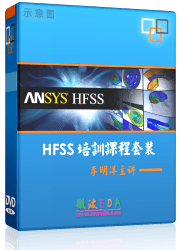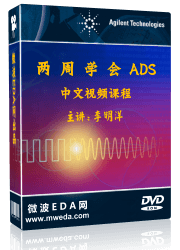|
 Ansoft Designer / Ansys Designer 在线帮助文档: Ansoft Designer / Ansys Designer 在线帮助文档:
Terms in Designer >
Glossary: F
Glossary: F
Fan-Out Via
In the case of surface mount devices attached to double-sided
or multilayer boards, each component pad is usually connected by a short
length of track to a via which forms a link to other conducting layers,
and this via is known as a fan-out via. The term fan-out via is generally
also taken to include any vias that fall inside the device's footprint
(under the body of the device). Some designers attempt to differentiate
these vias from those that fall outside the device's footprint by referring
to them as fan-in vias, but this is not an industry-standard term.
Falling-Edge
A transition from a logic 1 to a logic 0. Also known
as a negative edge.
Falltime
The time it takes for a waveform to transition from
the high logic state to the low logic state. Falltime is usually measured
from 90% of the total signal swing to 10% of the signal swing.
Fan-In and Fan-Out Vias
In the case of surface mount devices attached to double-sided
or multilayer boards, each component pad is usually connected by a short
length of track to a via which forms a link to other conducting layers,
and this via is known as a fan-out via. The term fan-out via is generally
also taken to include any vias that fall inside the device’s footprint
(under the body of the device). Some designers attempt to differentiate
these vias from those that fall outside the device’s footprint
by referring to them as fan-in vias, but this is not an industry-standard
term.
Femto
Unit qualifier (symbol = f) representing one thousandth
of one millionth of one millionth, or 10-15. For example, 3fS stands
for 3 x 10-15 seconds.
FET (Field-Effect Transistor)
A transistor whose control, or gate, signal creates
an electro-magnetic field which turns the transistor ON or OFF.
Field-Effect Transistor (FET)
A transistor whose control, or gate, signal creates
an electro-magnetic field which turns the transistor ON or OFF.
Field-Programmable Gate Array (FPGA)
A programmable logic device which is more versatile
than traditional programmable devices such as PALs and PLAs, but less
versatile than an application-specific integrated circuit. Some field-programmable
gate arrays use fuses such as those found in programmable logic devices,
but others are based on SRAM equivalents.
Field-Programmable Interconnect Chip (FPIC)
An alternative, proprietary name for a field-programmable
interconnect device (FPID).
Field-Programmable Interconnect Device (FPID)
A device which is used to connect logic devices together,
and which can be dynamically reconfigured in the same way as standard
SRAM-based FPGAs. Because each FPID may have around 1,000 pins, only
a few such devices are typically required on a circuit board.
Filter
Filters are used to block out undesired frequencies.
There are two types of filters: band pass and rejection. A band pass
filter permits only the desired range to pass through, while the rejection
filter attenuates an undesired range of frequencies.
Firmware
Refers to programs, or sequences of instructions,
that are hard-coded into non-volatile memory devices.
First-In First Out (FIFO)
A memory device in which data is read out in the same
order that it was written in.
Flash (i.e., Gold Flash)
An extremely thin layer of gold with a thickness measured
on the molecular level which is either electroplated or chemically plated
onto a surface.
FLASH Memory
An evolutionary technology that combines the best
features of the EPROM and E2PROM technologies. The name FLASH is derived
from the technology's fast reprogramming time compared to EPROM.
Flex (Flexible Printed Circuit)
A specialist circuit board technology, often abbreviated
to "flex", in which tracks are printed onto flexible materials. There
are a number of flavors of flex, including static flex, dynamic flex,
and rigid flex.
Flexible Printed Circuit (FPC)
A specialist circuit board technology, often abbreviated
to "flex", in which tracks are printed onto flexible materials. There
are a number of flavors of flex, including static flex, dynamic flex,
and rigid flex.
Flipped Chip
A generic name for processes in which unpackaged integrated
circuits are mounted directly onto a substrate with their component-sides
facing the substrate.
Flipped TAB
A combination of flipped chip and tape automated bonding.
Footprint
The area occupied by a device mounted on a substrate.
Fourier Analysis
A mathematical procedure used to determine the collection
of sine waves (differing in frequency and amplitude) that is necessary
to make up the square-wave pattern under consideration.
FPC (Flexible Printed Circuit)
A specialist circuit board technology, often abbreviated
to "flex", in which tracks are printed onto flexible materials. There
are a number of flavors of flex, including static flex, dynamic flex,
and rigid flex.
FPGA (Field-Programmable Gate Array)
A programmable logic device which is more versatile
than traditional programmable devices such as PALs and PLAs, but less
versatile than an application-specific integrated circuit. Some field-programmable
gate arrays use fuses such as those found in programmable logic devices,
but others are based on SRAM equivalents.
FPIC (Field-Programmable Interconnect Chip)
An alternative, proprietary name for a FPID (field-programmable
interconnect device).
FPID (Field-Programmable Interconnect Device)
A device which is used to connect logic devices together,
and which can be dynamically reconfigured in the same way as standard
SRAM-based FPGAs. Because each FPID may have around 1,000 pins, only
a few such devices are typically required on a circuit board.
FR4
The most commonly used insulating base material for
circuit boards. FR4 is made from woven glass fibers which are bonded
together with an epoxy. The board is cured using a combination of temperature
and pressure which causes the glass fibers to melt and bond together,
thereby giving the board strength and rigidity. The first two characters
stand for "Flame Retardant". FR4 is technically a form of fiberglass,
and some people do refer to these composites as fiberglass boards or
fiberglass substrates, but not often.
Free-Space Optical Interconnect
A form of optical interconnect in which laser-diode
transmitters communicate directly with photo-transistor receivers without
employing optical fibers or optical waveguides.
Full Custom
An application-specific integrated circuit in which
the designer has complete control over every mask layer used to fabricate
the device. The manufacturer does not provide a cell library or pre-fabricate
any components on the substrate.
Functional Latency
Refers to the fact that, at any given time, only a
portion of the logic functions in a device or system are typically active
(doing anything useful).
Functional Test
A test strategy in which signals are applied to a
circuit's inputs, and the resulting signals which are observed on the
circuit's outputs are compared to known good values.
Fuse (Fusible-Link Technology)
A programmable logic device technology which employs
links called fuses. Individual fuses can be removed by applying pulses
of relatively high voltage and current to the device's inputs.
Fusible-Link Technology
A programmable logic device technology which employs
links called fuses. Individual fuses can be removed by applying pulses
of relatively high voltage and current to the device's inputs.
Fuzz-Button
A small ball of fibrous gold used in one technique
for attaching components such as multichip modules to circuit boards.
Fuzz-buttons are inserted between the pads on the base of the package
and their corresponding pads on the board. When the package is forced
against the board, the fuzz-buttons compress to form good electrical
connections. Even when the pressure is removed, the fuzz-buttons act
in a similar manner to Velcro and continue to hold the component in
place. One of the main advantages of the fuzz-button approach is that
it allows broken devices to be quickly removed and replaced. Even though
fuzz-button technology would appear to be inherently unreliable, it
is used in such devices as missiles, so one can only assume that it
is fairly robust.




HFSS视频教程
ADS视频教程
CST视频教程
Ansoft Designer 中文教程
|